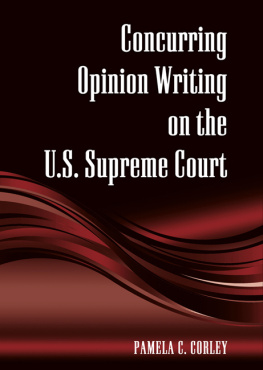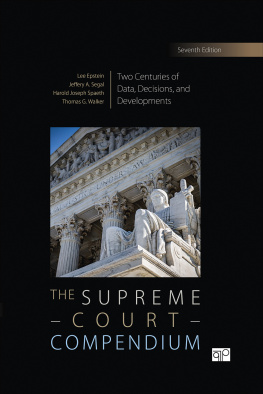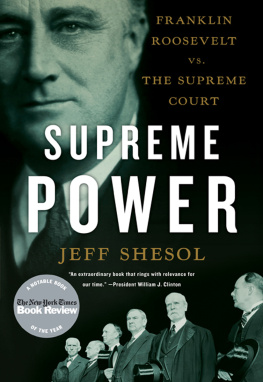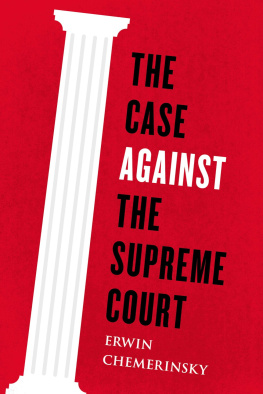Pamela C. Corley - Concurring Opinion Writing on the U.S. Supreme Court
Here you can read online Pamela C. Corley - Concurring Opinion Writing on the U.S. Supreme Court full text of the book (entire story) in english for free. Download pdf and epub, get meaning, cover and reviews about this ebook. City: Albany, year: 2010, publisher: SUNY Press, genre: Science. Description of the work, (preface) as well as reviews are available. Best literature library LitArk.com created for fans of good reading and offers a wide selection of genres:
Romance novel
Science fiction
Adventure
Detective
Science
History
Home and family
Prose
Art
Politics
Computer
Non-fiction
Religion
Business
Children
Humor
Choose a favorite category and find really read worthwhile books. Enjoy immersion in the world of imagination, feel the emotions of the characters or learn something new for yourself, make an fascinating discovery.
- Book:Concurring Opinion Writing on the U.S. Supreme Court
- Author:
- Publisher:SUNY Press
- Genre:
- Year:2010
- City:Albany
- Rating:3 / 5
- Favourites:Add to favourites
- Your mark:
- 60
- 1
- 2
- 3
- 4
- 5
Concurring Opinion Writing on the U.S. Supreme Court: summary, description and annotation
We offer to read an annotation, description, summary or preface (depends on what the author of the book "Concurring Opinion Writing on the U.S. Supreme Court" wrote himself). If you haven't found the necessary information about the book — write in the comments, we will try to find it.
Concurring Opinion Writing on the U.S. Supreme Court — read online for free the complete book (whole text) full work
Below is the text of the book, divided by pages. System saving the place of the last page read, allows you to conveniently read the book "Concurring Opinion Writing on the U.S. Supreme Court" online for free, without having to search again every time where you left off. Put a bookmark, and you can go to the page where you finished reading at any time.
Font size:
Interval:
Bookmark:

| Figures |
|---|
| Proportion of Cases with at Least One Concurrence Versus Proportion of Cases with at Least One Dissent |
| Proportion of Cases with Concurring and Dissenting Opinions, 19372004 Terms |
| Tables |
|---|
| Proportion of Cases with at Least One Concurrence Versus Proportion of Cases with at Least One Dissent |
| Summary of Hypotheses |
| Types of Concurrences, by Justice (19861989) |
| Results of Concurrence Model |
| Predicted Probabilities of Justices' Decisions to Write or Join a Specific Type of Concurrence Versus Joining the Majority Opinion (19861989) |
| Bargaining and Accommodation Between Blackmun and Marshall and the other Justices, 19861989 Terms |
| Distribution of the Types of Concurrences: Supreme Court Versus Courts of Appeals |
| Summary of Model of Impact of Concurrences on Lower Court Compliance |
| Predicted Probabilities of Positive Treatment by the Lower Courts |
| Summary of Model of Impact of Multiple Concurrences on Lower Court Compliance |
| Summary of the Impact of the Type of Concurrence on the Supreme Court's Positive Treatment of its Own Precedent |
| Predicted Probabilities of Positive Treatment by the Supreme Court |
| List of Cases, the Type of Concurrence, and the Justice Writing the Concurrence |
| Multinomial Logit Model of Justices' Decisions to Write or Join a Specific Type of Concurrence Versus Joining the Majority Decision (19861989 Terms) |
| Descriptive Statistics for Independent Variables in Multinomial Logit Model of Justices' Decisions to Write or Join a Specific Type of Concurrence Versus Joining the Majority Decision (19861989 Terms) |
| Logit Model of the Impact of Concurrences on Treatment of Supreme Court Precedent in the Courts of Appeals |
| Descriptive Statistics for Independent Variables in Logit Model of the Impact of Concurrences on Treatment of Supreme Court Precedent in the Courts of Appeals |
| Logit Model of the Impact of Multiple Concurrences on Treatment of Supreme Court Precedent in the Courts of Appeals |
| Predicted Probabilities of Positive Treatment, by Circuit |
| Logit Model of the Impact of Type of Concurrence on Positive Treatment of Supreme Court Precedent by the Supreme Court |
| Descriptive Statistics for Independent Variables in Logit Model of the Impact of the Type of Concurrence on Positive Treatment of Supreme Court Precedent by the Supreme Court |
Introduction
Font size:
Interval:
Bookmark:
Similar books «Concurring Opinion Writing on the U.S. Supreme Court»
Look at similar books to Concurring Opinion Writing on the U.S. Supreme Court. We have selected literature similar in name and meaning in the hope of providing readers with more options to find new, interesting, not yet read works.
Discussion, reviews of the book Concurring Opinion Writing on the U.S. Supreme Court and just readers' own opinions. Leave your comments, write what you think about the work, its meaning or the main characters. Specify what exactly you liked and what you didn't like, and why you think so.







